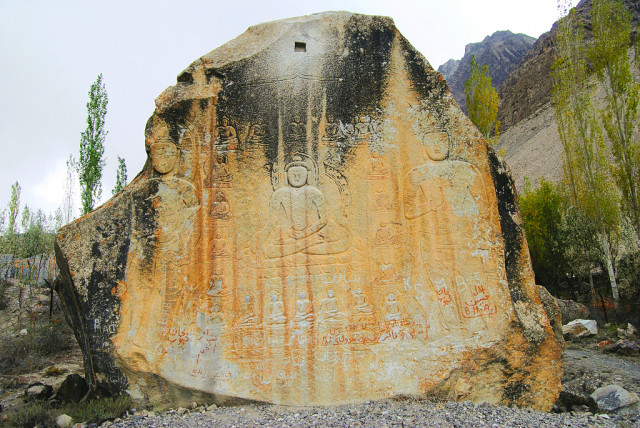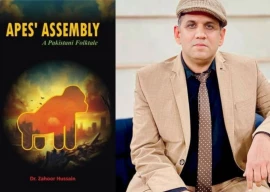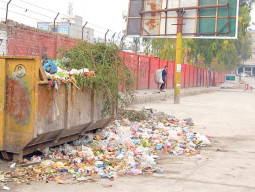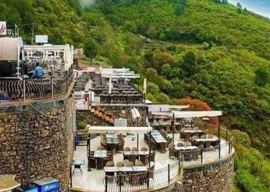
Resting at the edge of Manthal village on the left of a stream from Satpara Lake, the granite – known as the Buddha Rock – is pale and smooth. Believed to be carved between 8th and 10th centuries, the relic represents the glory of the past, of a time when men and women meditated in the footsteps of the ‘One Who Woke Up’.
It has the makings of a heritage site – bearing testimony to a tradition which has disappeared. Its significance goes beyond nationalities. Yet, it sits at the border of Manthal village, ignored and forgotten by the world.
 The serene and spotless Satpara Lake in Skardu. PHOTO COURTESY: MARYAM TARIQ
The serene and spotless Satpara Lake in Skardu. PHOTO COURTESY: MARYAM TARIQIt is widely believed in Pakistan that the rock was not known to most until British traveler Jane E Duncan documented it in the early 1900s. “I went to Sadpor in search of the carved rock which Rajah Spindia at Khapallu had told me about; three miles and a half from Skardo, and a few yards off the road to Sadpor, we came to the rock, which proved to be a large and important relic of antiquity,” Duncan wrote in her book ‘A Summer Ride Through Western Tibet’ about the 1904 trip to Skardu.
Wazir Ejaz, CEO of Baltistan Culture and Development Foundation (BCDF), tells us that Duncan―failing to understand the Tibetan inscription on the rock―copied it and sent it to German scholar August Hermann Francke who was working in Ladakh. “Francke deciphered the script in English and published it in Calcutta and the world came to know about this magnificent carving,” Ejaz says.
However, British Tibetologist Philip Denwood, in his 2007 article for Journal of Inner Asian Art & Archaeology 2, said the rock carvings and Tibetan inscriptions were noticed by GT Vigne and reproduced in 1836 and 1838. Denwood further wrote AGA Durand published a photograph of the whole rock in 1899.
Shedding light on the ancient relief, historian Muhammad Abbas Kazmi says the carving and Tibetan inscriptions were made on a 30-foot high and 20-foot wide triangle-shaped rock. “The carving depicts present time Buddha—Siddhārtha Gautama—in the centre, 20 smaller Buddhas of the past around him and future Buddhas – Maitreya – standing on both sides,” Kazmi interprets. He claims that in Buddhist tradition, the ‘Council of all Buddhas’ as represented in the carving is called ‘Mandal’ – a word from which the village’s name is derived.
 Tibetan text engraved on Buddha Rock. PHOTO COURTESY: BCDF
Tibetan text engraved on Buddha Rock. PHOTO COURTESY: BCDFAll the Buddhas, except the Maitreyas, are shown resting on lotuses in Bhumisparsha position which means ‘touching the earth’ and signifies the moment of enlightenment for Gautama. It is the moment when Buddha, after six years of hardship, decides to sit under a tree and not move until he achieves supreme and final wisdom. He is distracted by Mara, the lord of desire, but to no use. Gautama resisted every temptation and as the final test, Mara challenged Buddha to tell him who would bear witness to his worthiness to attain wisdom. Gautama said nothing and touched the ground beneath him. The earth shook. “The earth is my witness,” Buddha said.
The Tibetan script on the Buddha Rock, though incomplete at many places, instructs the followers of Gautama to take care of this sculpture. “The faithful ones (should) from time to time (make the colours of the sculptures) bright, and clean the place of offering that it may not decay,” says the text, as translated by Franke in the 20th century. Kazmi says only one of the three-part text is visible today but the entire script—with only a few characters missing—was on the rock when Duncan examined it.

In her book, Duncan wrote that she submitted copies of the inscription to several Buddhist scholars in London and Paris but because of the missing characters, none could give a rendering. “I wrote to Mr Francke telling him of my difficulty in getting a good translation, and he immediately sent a competent Tibetan from Khalatse to Sadpor to make new copies and this man was able to fill up many of my blank spaces, as he recognised numerous letters which had been partly destroyed,” the British traveler wrote, expressing amusement over the Tibetan charging just Rs12 for his long and fatiguing journey to the rock and back and his trouble in making the copies.
Francke, who translated the ancient text, said that “judging from the orthography employed, the writing is as old as those at Balu-mkhar, dating from not later than 1000 AD and, imperfect as they are, are of great philological and antiquarian interest; they all seem to refer to the sculptures on the rock." He added, “Line No 8 in the third of them seems to indicate that the sculptures of Buddha are much older than the inscriptions themselves.”
 Present time Buddha, Siddhãrtha Gautama, craved in the middle of the rock. PHOTO COURTESY: BCDF
Present time Buddha, Siddhãrtha Gautama, craved in the middle of the rock. PHOTO COURTESY: BCDFDuncan, in her travelogue, wrote that the hole was used to hold light. “At the top of the rock above the Buddha's head there is a square hole, which the chowkidar, who acted as my guide, said was used for holding a light, and the stone round it looks smoke-blackened,” she wrote.A prominent feature of the relic is a square cube cut out at the top of the stone. Last summer, when I arrived here, I saw visitors aiming to throw pebbles inside the hollow boxy space in fulfillment of a myth that praying and then throwing a stone inside the cube successfully will make a wish come true—a local spin on European wishing wells and lovers’ locks.
Historian Kazmi, however, says the space was probably used to hold a beam with support from both sides of the stone to carry a roof. “The square recess and cuts on the edges very clearly indicate that in the beginning there was a canopy over the rock-face of the carving to protect it from weather effects,” he explains. Buddhism specialist Dr Christian Luczanits concurs, pointing out that the images were probably painted originally and the roof had protected the paintings.
 A copy of a portion of Tibetan text engraved on Buddha Rock. SOURCE: JANE E DUNCAN’S A SUMMER RIDE THROUGH WESTERN TIBET
A copy of a portion of Tibetan text engraved on Buddha Rock. SOURCE: JANE E DUNCAN’S A SUMMER RIDE THROUGH WESTERN TIBETThe exact purpose may remain a mystery for years to come or maybe even be lost forever if the relic is not protected from wear and tear caused by nature and humans. “The sculpture should have been declared a heritage site by UNESCO long ago, but the government and BCDF have failed to make efforts to preserve the eroding piece of history,” Kazmi says, pleading to authorities to pay attention to the relic.
Pakistan, which hosts six world heritage sites, has failed to even mention the Buddha Rock in its Tentative List from which the UN body picks places of ‘special cultural or physical significance’. The last inventory was complied in 2004 in which ten nominations were made in addition to 1993’s eight recommendations. And as per the rules, Pakistan can re-examine the list at least every ten years.
Ejaz says the BCDF―which has Buddha Rock on lease for 90 years―considered recommending it to UNESCO for a heritage site as well as for one of its awards, but did not do so because the relic does not fulfill their criteria.
Dr Luczanits sees this rock carving as part of a larger group of Buddhist relics in the region, which he recommends to be declared a heritage site together. “What is more important is to create awareness locally to ensure protection of the site as part of the heritage,” the Buddhism expert says. And BCDF’s chief Ejaz tells us that for this purpose, his organisation has constructed a boundary wall around the rock and deployed a security guard to facilitate tourists. “The BCDF has also constructed a tourist hut nearby in collaboration with the government’s tourism department and submitted proposals to different donor agencies to preserve its writings and images,” adds Ejaz.
 Crystal clear Satpara Lake. PHOTO COURTESY: MARYAM TARIQ
Crystal clear Satpara Lake. PHOTO COURTESY: MARYAM TARIQProtection of the site is crucial for preserving history as many believe this place was important for the spread of Buddhism in the area and served as a pilgrimage site for worshippers from far and wide. However, there is no concrete evidence to prove the exact use of the place.
“Such rock carvings are usually at spots that are widely visible and thus serve as a reminder of Buddhism in general, besides having a more specific local ritual function that we cannot reconstruct today anymore, except for its latest use like recorded by Ms Duncan for the square recess on Buddha Rock,” Dr Luczanits tells us.
The real story behind the stone may never unravel, but Kazmi vouches for the uniqueness of the carving. “Nowhere in the Buddhist world has anyone seen the depiction of all Buddhas in such a magnificent style,” he claims to point out the importance of Baltistan, and Skardu in particular, in the Buddhist history of the region. “Even in Lhasa, China—which has been the center of Mahayana Buddhism and the seat of Buddhist kings and fourteen Dalai Lamas—such a glorious picture has not been carved,” he says with a hint of pride.
Buddhism expert Dr Luczanits says the relief is part of a larger group all along the southern edge of the western Himalayas where rocks were used to depict Buddhist imagery. “The one in Skardu is unique in its composition, high quality carving and the number of Buddhas depicted; the carving emphasises the cosmic quality of the Buddha through the repetition of his image around him,” he says.
 An older image showing the entrance to the historic site. The barbed-wire boundary has now been replaced with a concrete wall. PHOTO COURTESY: BCDF
An older image showing the entrance to the historic site. The barbed-wire boundary has now been replaced with a concrete wall. PHOTO COURTESY: BCDFBaltistan was the land of Shamanism until Buddhism arrived in the 4th Century with the monks from Northern India, well before it entered Ladakh and Tibet. Many monasteries were built during the Palolashahi kingdom that ruled the area and the religion continued to flourish after the Tibetan conquest of the region in the second quarter of the 8th Century.
In the 14th Century, Ali Hamadani and his followers arrived from Iran and changed the landscape forever. Locals embraced Islam and Buddhism vanished from their daily lives. The places of worship fell into despair due to no visitors and because the preachers of the new religion called for shunning the past. “By the 15th Century, no Buddhist was left in Baltistan and the Muslim population wreaked havoc on the Buddhist legacy, destroying religious buildings and monuments,” claims Kazmi, adding that many dug out the foundations of religious sites in search of wealth believed to be buried by Buddhist kings and lamas. More recently, in 2007 the Taliban in Swat defaced the biggest Buddha sculpture in the world, second only to the monumental statues in Bamiyan, Afghanistan, which were destroyed in 2001 by the Afghan Taliban.
‘The Little Tibet’ and its Buddhist heritage disappeared over time, but what mysteriously survived was the Buddha Rock among a handful of artifacts. “In the midst of a purely Mohammedan population, these monuments have been allowed to remain intact except for the partial defacement of the inscriptions, while over the rest of the country every trace of its ancient religion appears to have been destroyed,” Duncan wrote in surprise.
Dr Luczanits says it is not uncommon that such rock carvings were either ignored once the religion changed or reinterpreted to attain a new meaning for the locals.
In this case it appears, Buddha was simply left in peace.
Ferya Ilyas is a senior subeditor at The Express Tribune. She tweets @ferya_ilyas
An abridged version of this article was published in The Express Tribune, Sunday Magazine, July 26th, 2015.



















COMMENTS
Comments are moderated and generally will be posted if they are on-topic and not abusive.
For more information, please see our Comments FAQ